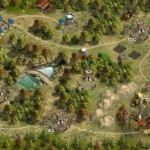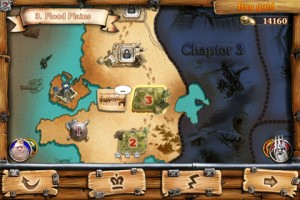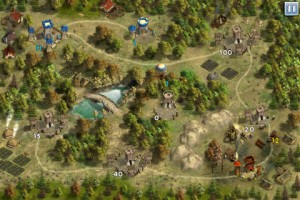 You are King Flabbian IV and your mission is to protect the Kingdom of Baldoria. Still with me? Well as you can guess from the King’s name (he’s a fatty), the tone of Fantasy Conflict isn’t exactly serious. While the presentation of the game may be that of medieval mockery though, the actual gameplay is fast, brutal and challenging.
You are King Flabbian IV and your mission is to protect the Kingdom of Baldoria. Still with me? Well as you can guess from the King’s name (he’s a fatty), the tone of Fantasy Conflict isn’t exactly serious. While the presentation of the game may be that of medieval mockery though, the actual gameplay is fast, brutal and challenging.
You face off against the greedy dwarves who have stolen your crystal, and to get it back you face them in a series of tactical skirmishes. Viewed from a top down perspective, you are presented with a series of castles and other fortifications interconnected by a complex series of roads. You start with one of these castles in your control, and each one that you capture will slowly spawn more troops. As the number of troops in a castle rises, depicted by a number under the structure, you can send them out to capture nearby empty castles or attack the enemies. It will take a specific number of troops to capture each castle, so waiting until you can send enough troops to take it in one attack is a key strategy. You can only send troops to the nearest castle, so constantly moving the troops that have accrued at the back castles to the front ones is what you spend most of your time doing.
 The key to victory is to expand quickly, choosing the right moments to move your troops and capturing as many as you can as quickly as possible. All the while you have to watch out for enemy troops though, countering their movements and reacting to the areas they capture. Its frenetic and engaging, and often when it seems like victory is close at hand a moment of lapsed concentration can see the tide quickly turn.
The key to victory is to expand quickly, choosing the right moments to move your troops and capturing as many as you can as quickly as possible. All the while you have to watch out for enemy troops though, countering their movements and reacting to the areas they capture. Its frenetic and engaging, and often when it seems like victory is close at hand a moment of lapsed concentration can see the tide quickly turn.
If this was all there was to the game then it would be very simple, so Gaijin Entertainment have added a number of different systems to make things more interesting. First of all you can fortify the castles you capture to make them harder to capture. You can even add cannons and other defences to make them attack incoming enemies. There are also different unit types, with some buildings creating attack balloons instead of ground troops.
There’s also a magic system at work. You can attack the enemy with lighting, fire and a number of other types of spell. These are great fun when you use them, but when the enemy is attacking you with them it can be hard to tell what is happening or why you are losing. Remembering to make use of magic when you are so absorbed in moving your troops from castle to castle can be tough too.
 Fantasy Conflict looks nice too. It’s not consistent though. The menu screens and sections between levels have a childish cartoon feel somewhere between Fable and WOW, while the actual game looks retro with some moody, well drawn sprites. It looks like a classic PC strategy title.
Fantasy Conflict looks nice too. It’s not consistent though. The menu screens and sections between levels have a childish cartoon feel somewhere between Fable and WOW, while the actual game looks retro with some moody, well drawn sprites. It looks like a classic PC strategy title.
Fantasy Conflict isn’t really a strategy game though, or at least not a conventionally paced one. Its non-stop action, and its reliant on quick reactions as much as quick decision making. For me this is a shame. While the game is fun enough, its exhausting to play more than a few levels. Defeat is frustrating and often you’re not entirely sure how things went wrong. Little achievements associated with each level seem like a good idea initially, but as you fail to achieve these optional goals the urge to retry the level is strong, and sadly the urge to simply quit and play something else can be strong too.
Fantasy Conflict isn’t a bad game. Combining strategy and a kind of remixed tower defence, its a good idea. With some tweaking it could be very good. Maybe if the overall speed of the game was reduced I would enjoy it more. As it is though..
6 frantic reviewers, smudging screens frenziedly out of 10
